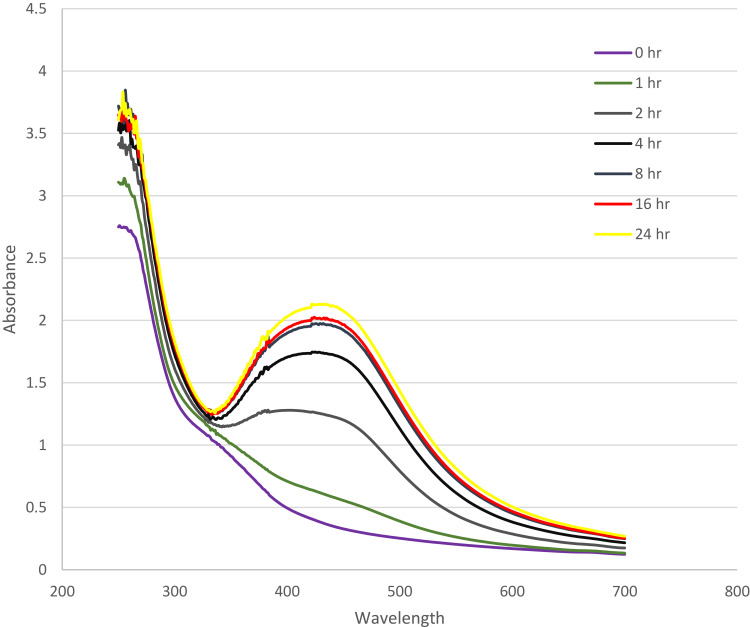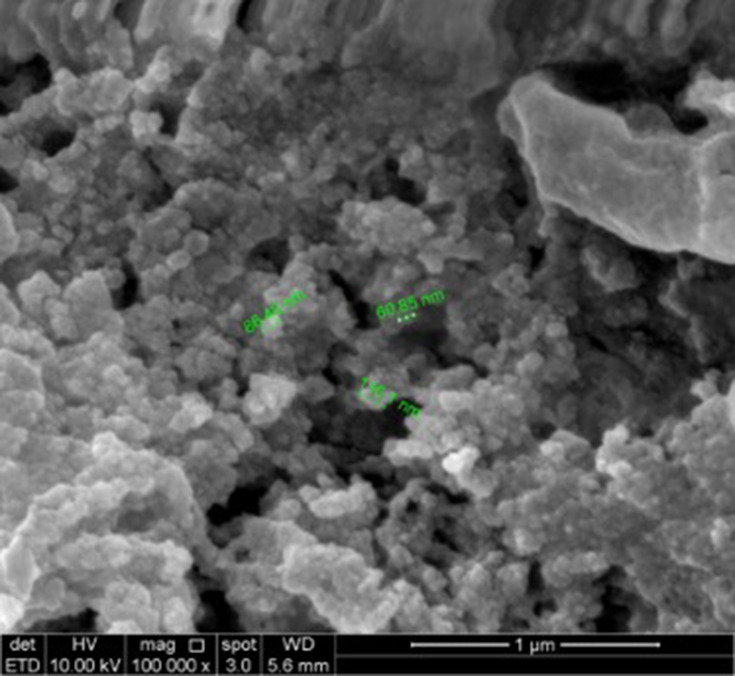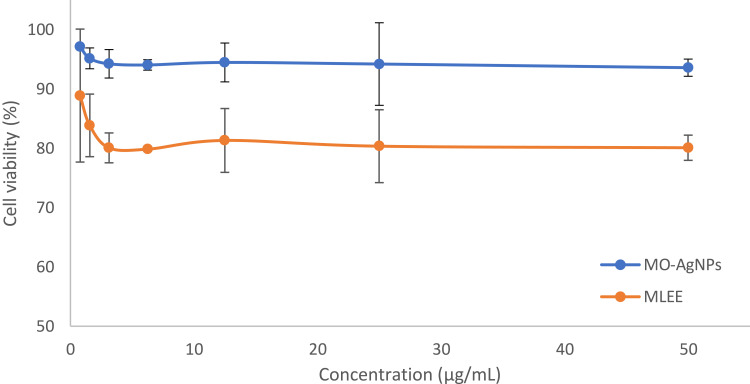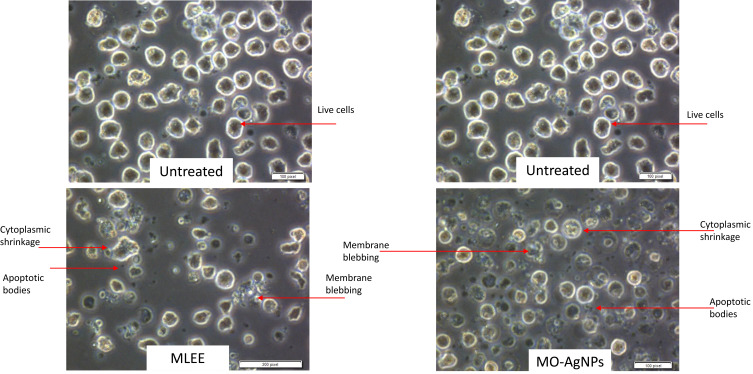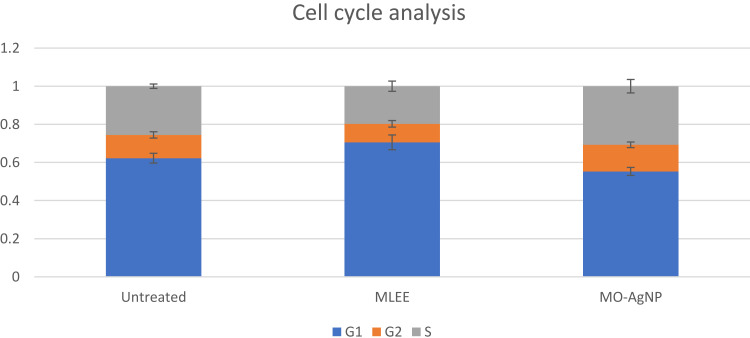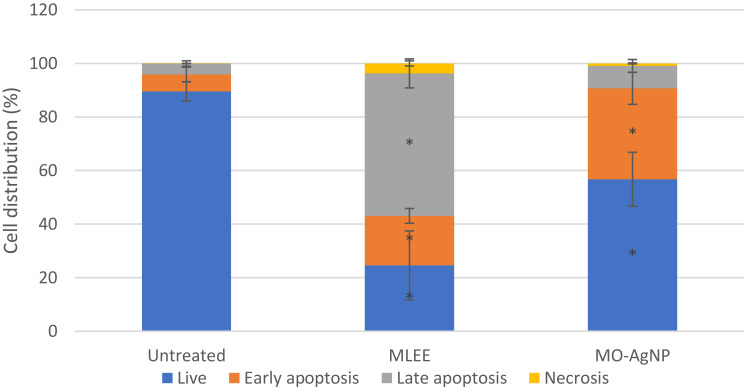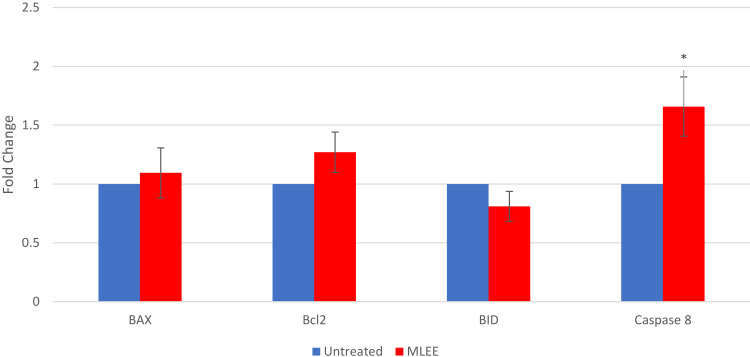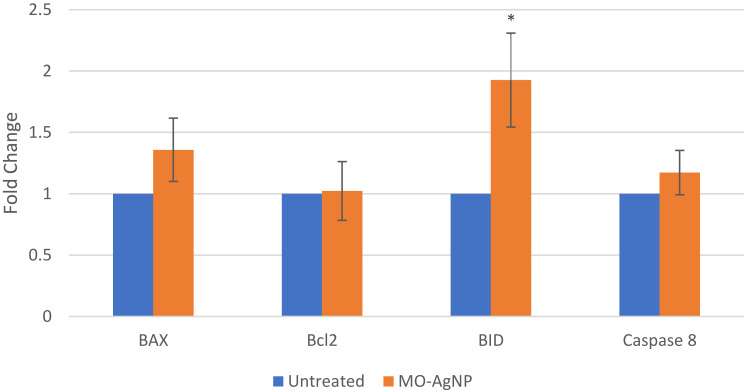Abstract
Background
Moringa oleifera, commonly known as “moringa”, is widely cultivated in tropical and subtropical regions across the globe. Extensive studies have shown that various parts of the moringa tree exhibit anti-cancer properties. This study determined the effects of sequential moringa leaf extracts and silver nanoparticles synthesized from moringa leaf extract on Kasumi-1 leukemia cells.
Methods and Results
Dried moringa leaf powder was sequentially extracted with the assistance of ultrasound starting with absolute ethanol, followed by 50% ethanol, and finally, deionized water. The aqueous extract was utilized to synthesize silver nanoparticles. The optimum conditions to generate moringa silver nanoparticles (MO-AgNPs) were eight hours of incubation at 60°C with 1 mM silver nitrate and 1% moringa aqueous extract from sequential extraction. The three extracts and MO-AgNPs were used to treat Kasumi-1 cells for 24, 48, 72 hours with concentrations ranging from 400 to 12.5 µg/mL, while cell viability was determined with 3(4, 5-dimethythiazol-2-yl)-2, 5-diphenyltetrazolium bromide (MTT) assay. After 72 hours of treatment, the moringa leaf absolute ethanol extract displayed the strongest inhibitory effects on Kasumi-1 cells with IC50 of 10 µg/mL, in comparison to moringa leaf 50% ethanol extract (25 µg/mL) and aqueous extract (>400 µg/mL). Interestingly, MO-AgNPs exhibited the strongest cytotoxic effects on Kasumi-1 cells with an IC50 of 7.5 µg/mL. Cytotoxic study on normal CD34+ cells treated with up to 50ug/mL of either MO-AgNPs or ethanol extract still had more than 80% cell viability indicating that the treatments have selective cytotoxicity against the cancer cells. Morphological studies of Kasumi-1 cells treated with IC50 of moringa leaf ethanolic extract and MO-AgNPs show a lot of shrinking, dying cells and cell debris. Cell cycle studies displayed an increase in cells at the G1 phase for ethanol leaf extract, while MO-AgNPs caused cell cycle arrest at the S phase after treatment with IC50 dose for 24 hours. Moringa leaf ethanol extract and the nanoparticles induced apoptosis in Kasumi-1 cells as shown by annexin V – FITC assays. Gene expression analysis by qPCR verified these outcomes, as the moringa leaf ethanol extract led to significant upregulation of proapoptotic gene caspase 8, whereas the MO-AgNPs caused a significant increase of proapoptotic protein BID.
Conclusion
This study reveals that moringa ethanolic leaf extract and MO-AgNPs induced potent antiproliferative effects in Kasumi-1 cells by apoptosis.
Keywords: ultrasound, sequential extraction, green synthesis, silver nanoparticles, leukemia
Introduction
Silver nanoparticle (AgNPs) have drawn a lot of research interest in recent years in the field of nanomedicine due to their potential in a broad range of biomedical applications.1 AgNPs have been utilized for imaging, diagnostics, biomedical devices antibacterial, drug delivery and anticancer.2–6 AgNPs can be produced via physical, chemical and biological methods, however the bio-based methods, especially synthesis with plant extracts have grown in popularity due to the relatively cheap and easy production and environmentally friendly aspects of the process.7 The synthesis of AgNPs by using plant extracts is widely known as “green synthesis” due to the non-toxic nature of the process when compared to conventional chemical synthesis of AgNPs.8 The green synthesis of AgNPs has enabled many researchers to produce AgNPs in a lab setting without the need of specialized facilities and equipment which has sped up research on the AgNPs derived from plant extracts. There have been a number of studies which demonstrated the antimicrobial, antifungal and anticancer effects of plant-derived AgNPs.9–11 The immense potential of the AgNPs has triggered a lot of research on AgNPs to fully utilize them in the biomedical field.12,13
Moringa oleifera which is also known as the drumstick tree, ben oil tree, horseradish tree, miracle tree or simply as moringa is a deciduous tree that is native to South Asia.14 The plant is widely grown in its native land and prized for its culinary uses and uses in traditional medicine. The cultivation of the plant has spread far and wide due to its abundant uses. All parts of the moringa plant can be utilized. For example, the leaves and seed pods are eaten as vegetables, the seeds can be pressed to extract oils and the pressed seed cakes can be used as a natural flocculating agent to clarify turbid water and the bark and roots are used in traditional medicine to treat a wide range of diseases.15–19 There have been a few studies which demonstrated the anticancer activity of extracts from different parts of the moringa tree on different cell lines such as HeLa (cervical cancer), A549 (lung cancer) and Hep-2 (epidermoid cancer).20–22 These studies show that the moringa plant could be a potential source of anticancer compounds.
In light of this, we decided to use Moringa oleifera leaf extract to synthesize AgNPs using the green synthesis method and test out its effects on Kasumi-1 (leukemia) cells. In this study, we also compared the cytotoxic effects of the M.oleifera leaf extracts and the AgNPs produced from the M.oleifera leaf extract and try to determine the cell death mode induced by the treatments.
Materials and Methods
Extraction of Moringa oleifera Leaf
Dried Moringa oleifera leaf powder was bought from Herbagus, Kepala Batas, Malaysia. A voucher specimen (Herbarium No: 11799) was deposited at the herbarium of School of Biological Sciences, Universiti Sains Malaysia. Twenty-five grams of moringa leaf powder was mixed with 250 mL of absolute ethanol (Systerm, Malaysia). The mixture was sonicated in the Mujigae sonicator for 30 minutes. The mixture was then centrifuged at 6000 rpm for 15 minutes and the supernatant was collected. The pellet was further extracted with absolute ethanol two more times. The pellet from the absolute ethanol extraction was allowed to dry in the fumehood and then extracted with 50% ethanol as before for three times. Finally, the pellet was dried and extracted as before with deionized water for three times. The three different extracts then had their solvents removed, ethanol by using the Buchi rotavapor, and water using the Alpha 1–4 LSC freeze dryer to obtain dried extracts. The three different extracts produced are the moringa leaf absolute ethanol extract (MLEE), moringa leaf 50% ethanol extract (50%MLEE) and the moringa leaf aqueous extract (MLAE).
Synthesis of M. oleifera Nanoparticles (MO-AgNPs) and Characterization
The moringa nanoparticles (MO-AgNPs) were synthesized using the one pot green synthesis method. The optimized conditions of the synthesis are 90 mL of 1 mM silver nitrate added to 10 mL 1% MLAE which undergoes eight hours of incubation at 60°C with agitation. The synthesis of the MO-AgNPs was monitored using UV-Vis spectrometry to determine formation of the nanoparticles. The synthesized nanoparticles were then harvested by centrifuging at 6000rpm for 30 minutes. The MO-AgNPs were then freeze dried to obtain the dried nanoparticles. The MO-AgNPs were characterized by scanning electron microscopy (Leo Supra 50 VP, Zeiss) and transmission electron microscopy (Libra 120 electron microscope, Zeiss).
Cell Culture
The Kasumi-1 cells were purchased from ATCC and were maintained in RPMI 1640 (Millipore, Merck) medium supplemented with 10% fetal bovine serum (Sigma), 100 U/mL penicillin, and 100 μg/mL streptomycin (Gibco) at 37°C in humidified air with 5% CO2.
The bone marrow CD34+ cells were purchased from ATCC and thawed using IMDM containing 10% FBS and 20 U/mL Deoxyribonuclease I (Sigma) and grown in Iscove’s Modified Dulbecco’s Medium (IMDM, Lonza) supplemented with 15% fetal bovine serum, 1% penicillin-streptomycin, 10 μg (25 ng/mL) stem cell factor (Sigma), 4 μg (10 ng/mL) In-6 and In-3 (Sigma). The cells were cultured in a 5% carbon dioxide humidified atmosphere at 37°C.
Cell Viability and Cell Morphology Assay
The cytotoxicity of the extracts and MO-AgNPs was studied in the human Kasumi-1 cells using the standard thiazolyl blue tetrazolium bromide (MTT) assay. 10,000 cells/well were seeded in a 96 well plate. The cells were allowed to recover for 3 hours. The cells were then treated with different concentrations of extracts or MO-AgNPs ranging from 400ug/mL, 200ug/mL, 100ug/mL, 50ug/mL, 25ug/mL and 12.5ug/mL for 24hr, 48hr and 72hr. After each treatment was completed, the plate was centrifuged for 5 minutes at 1500rpm to pellet the cells. The treatment media was then aspirated and 100ul of media containing 10% v/v MTT reagent (5mg/mL) (Sigma) was added into each well. The plate was incubated for 4 hours and centrifuged once more for 5 minutes at 1500rpm. The MTT media was aspirated and 100ul of dimethyl sulphoxide (DMSO) (Merck) was added into each well. The plate was shaken on a plate shaker to completely dissolve the resulting formazan. The absorbance was measured at wavelength of 570nm with 620nm as the reference wavelength. The assay was conducted in triplicates.
Cell viability = (absorbance of treated cells/absorbance of untreated cells) * 100%
The IC50 value of each treatment was determined by examining the dose when cell viability is reduced to 50%.
The cytotoxicity of the MO-AgNPs and MLEE was tested on the normal control cells CD34+ cells at concentration of 50ug/mL, 25ug/mL, 12.5ug/mL, 6.25ug/mL, 3.125ug/mL, 1.563ug/mL, and 0.781ug/mL for 72 hr using the MTT assay as described previously.
The Kasumi-1 cells morphology assay was performed by treating the cells with the IC50 value of the MLEE or MO-AgNPs for 24hr, 48hr and 72hr. The cells were observed at each timepoint using a microscope. Images of treated cells were captured and compared with untreated control cells.
Cell Cycle Analysis and Apoptosis Assay
1 million Kasumi-1 cells were treated with the IC50 value of the MLEE or MO-AgNPs for 24 hours for the cell cycle analysis. After treatment, the cells were fixed in 70% ethanol for 2 hours. The fixed cells were resuspended in PBS containing 0.1% triton-X and RNase A. The cells were then incubated with propidium iodide (PI) (Sigma) and analysed with the BD-FACS flow cytometer. Further analysis was done using the ModFit program. For the apoptosis assay, 500,000 Kasumi-1 cells were treated with the IC50 of the MLEE or MO-AgNPs for 72 hours. The cells were harvested and further methods were done using the annexin V – FITC apoptosis kit (Sigma Aldrich) according to its manufacturer’s protocol. The cells were then analysed with the BD-FACS flow cytometer.
qPCR Analysis
One million Kasumi-1 cells were treated with the IC50 of the MLEE or MO-AgNPs for 72 hours. After incubation, the cells were harvested and the RNA was extracted using the RNeasy kit (Qiagen) according to manufacture’s protocol. The RNA was then converted into complementary DNA using the Quantinova cDNA synthesis kit (Qiagen) according to the manufacturer’s protocol. The expression levels of four apoptosis genes: Bax, Bcl2, BID and caspase 8 were determined using the Quantinova SYBR green PCR kit (Qiagen) according to the manufacturer’s protocol with GAPDH as the control.
Statistical Analysis
All the data are presented as the mean ± standard deviation. The paired t-test was used for significance testing, and P < 0.05 was considered to be statistically significant. All tests were performed using SPSS version 25.0 (SPSS Inc, Chicago, IL)
Results and Discussion
Moringa oleifera Leaf Extract and MO-AgNPs
The three sequential extracts isolated from the moringa leaf have distinct appearance when compared to each other. The MLEE is a deep green sticky paste as it contains most of the resins and compounds soluble in ethanol. The 50% MLEE was in the form of a brownish green flaky powder as there was less resin or chlorophyll to be extracted. Finally, the MLAE was a light green flaky powder since it extracted whatever compounds that were left over from the previous 2 extractions.23 The Moringa oleifera mediated silver nanoparticles (MO-AgNPs) formation was observed by the physical change of the color of the mixture from a clear yellowish liquid to a brownish solution and into a dark turbid liquid at the end of the eight hour incubation. This indicates the conversion of colourless silver ions (Ag+) into silver molecules that can block out light hence the change in color. The UV-Vis spectrometry of the reaction over time as shown in Figure 1, clearly shows the formation of the distinct peak around 430nm which is a clear sign of the formation of AgNPs.24
Figure 1.
The UV-Vis spectrometry absorbance spectrum of MO-AgNPs synthesised from 1% moringa aqueous leaf extract and 1mM silver nitrate (AgNO3) over time.
Note: The mixture was incubated at 60°C with shaking.
Characterization of MO-AgNPs
The MO-AgNPs was imaged with scanning electron microscopy (SEM) and transmission electron microscopy (TEM). Based on the images obtained in Figures 2 and 3, most of the MO-AgNPs produced have a size of less than 100nm and are round in shape. Therefore, it was determined that the MO-AgNPs are nanoparticles since they fall within range of the size of nanoparticles which is between 10–100nm.
Figure 2.
Scanning electron microscope (SEM) image of MO-AgNPs.
Note: 100 000x magnification.
Figure 3.
Transmission electron microscope (TEM) image of MO-AgNPs.
Note: 25 000x magnification.
Cell Viability and Cell Morphology Assay
The MTT assay for the three different extracts (MLEE, 50%MLEE, MLAE) and MO-AgNPs over the three timelines of 24, 48 and 72hrs shows that MO-AgNPs is the most cytotoxic compared to all the tested compounds with the lowest IC50 value for all timelines tested as shown in Figure 4 (IC50:7.5ug/mL at 72hrs). For the three moringa leaf extracts, at 72 hours the MLEE was the most cytotoxic against the Kasumi-1 cells (IC50:10ug/mL) followed with the 50% MLEE (IC50:25ug/mL) and lastly the MLAE (IC50: >400ug/mL) which was not considered cytotoxic against the Kasumi-1 cells. The reason for this diminishing cytotoxicity is due to the sequential extraction of the moringa leaf. The least polar solvent – ethanol, extracted most of phenolic and flavonoid compounds which are usually the most cytotoxic against cancer cells as observed in previous studies,25,26 while subsequent extractions with more polar solvents contain lesser active metabolites but more plant proteins, starches and sugar which is less cytotoxic against the cancer cells. This was clearly observed in the three sequential extracts of moringa leaf when tested on the Kasumi-1 cells. More detailed characterization of the different sequential extracts in the future will be able to determine the possible active compounds responsible for this discrepancy in cytotoxic effects. The MO-AgNPs which was the most cytotoxic against the Kasumi-1 cells was synthesized from the MLAE. This shows that green synthesis MO-AgNPs improved the cytotoxicity of the MLAE significantly which could be caused by the synergistic effect of the synthesized silver nanoparticles and the biological coating of the plant extract on the external surface of the nanoparticle.27 Testing of the MO-AgNPs and MLEE on normal CD34+ hematopoietic stem cell shows that at the highest tested dose of 50ug/mL which was higher than the IC50 of the MO-AgNPs and MLEE on the Kasumi-1 cells, the cell viability of the CD34+ was greater than 80% as shown in Figure 5. The results show that the compounds have selective cytotoxicity towards cancer cells compared to normal cells. The cell morphology assay clearly shows that the Kasumi-1 cells treated with the MLEE or MO-AgNPs at their respective IC50 values were under stress and dying especially when compared to the untreated cells. Based on Figure 6, the dying cells displayed membrane blebbing, cytoplasmic shrinkage and formation of apoptotic bodies which are all distinct characteristics of cells undergoing apoptosis. These characteristics are all consistent with the findings from a study that induced apoptosis in leukemic cell lines.28
Figure 4.
The cell viability of Kasumi-1 cells after incubation with various concentrations of moringa leaf extract and MO-AgNPs for 72 hours.
Figure 5.
The cell viability of CD34+ cells after incubation with various concentrations of moringa leaf ethanol extract and MO-AgNPs for 72 hours.
Figure 6.
The cell morphology of Kasumi-1 cells after treatment with IC50 of moringa leaf ethanol extract or MO-AgNPs for 72 hours under 400x magnification.
Cell Cycle Analysis and Apoptosis Assay
Based on the cell cycle results in Figure 7, it was observed that the ethanol extract caused cell cycle arrest at G1 phase while MO-AgNPs caused cell cycle arrest at the S phase. Cell cycle arrest can lead to apoptosis if the cells are unable to overcome the stress induced by treatment.29 In a previous study by Gajendran et al, silver nanoparticles induced cytotoxicity in breast cancer cell line – MCF-7 by inducing cell cycle arrest that led to apoptosis.30 The same pattern was observed in this study whereby the apoptosis assay showed a clear shift of cells towards the apoptosis stage for both treatments. Ethanol extract caused a lot of cells to accumulate in the late apoptosis stage in which there was 49% increment when compared to an untreated control, which is similar to the findings obtained by Al-Asmari et al. In the study by Al-Asmari et al, it was found that treatment with moringa leaf ethanol extract caused the breast cancer MDA-MB-231 cells and colorectal cancer HT-29 cells to be in the late apoptosis stage.31 This suggests that the compounds present in the moringa leaf ethanol extract are capable of inducing late apoptosis in different types of cancer cells. MO-AgNPs, on the other hand, caused the cells to accumulate in the early apoptosis stage with an increment around 29% as shown in Figures 8 and 9. The possible mechanism whereby the MLEE and Mo-AgNPs induce apoptosis is by inducing ROS production in the cells. In previous studies moringa leaf extract and moringa plant-derived silver nanoparticles have been shown to induce apoptosis in different cell lines such as melanoma – A2058 cells, cervical cancer – HeLa cells, lung cancer – A549 cells,32–34 It was observed that both treatments caused cell cycle arrests at different stages of the cell cycle and caused apoptosis shifts that were also different. This indicates that different treatments achieve similar results via different pathways.
Figure 7.
The distribution of cells in the different phases of the cell cycle after treatment with IC50 of moringa leaf ethanol extract or MO-AgNPs for 24 hours.
Notes: Experiments were carried out in 3 biological replicates (N=3). Error bar shows standard deviation. Level of significance was determined using paired sample t test.
Figure 8.
A representative distribution of the Kasumi-1 cells after treatment with IC50 of moringa leaf ethanol extract or MO-AgNPs for 72 hours.
Note: (A) Untreated cells. (B) Cells treated with MO-AgNPs. (C) Cells treated with MLEE.
Figure 9.
The distribution of the Kasumi-1 cells after treatment with IC50 of moringa leaf ethanol extract or MO-AgNPs for 72 hours.
Notes: Experiments were carried out in 3 biological replicates (N=3). Error bar shows standard deviation. Level of significance was determined using paired sample t test. *p < 0.05.
qPCR Analysis
The qPCR of a selection of apoptosis genes further supports this theory as both treatments caused the upregulation of different genes. Based on the results of the relative expression, MLEE caused significant upregulation of the proapoptotic gene caspase 8 (Figure 10). This gene is known to be mainly involved in an extrinsic pathway of apoptosis cell death.35 The extrinsic pathway of apoptosis is triggered via the binding of tumor necrosis factor (TNF) receptors which are present on the membrane of the cells and triggering the caspase cascade.36 This suggests that the compounds present in MLEE are capable of activating to the TNF receptors or the caspases involved in causing apoptosis. Conversely, MO-AgNPs induced significant upregulation of the proapoptotic gene BID (Figure 11). This gene has been well reported to be involved in an intrinsic pathway of apoptotic cell death. The intrinsic pathway of apoptosis is activated via the permeabilization of the mitochondria membrane.36 It appears that the MO-AgNPs are capable of entering the cells and disrupting the mitochondria to trigger apoptosis. The extract and MO-AgNPs induced different apoptotic pathways which might be due to different ways they act on the Kasumi-1 cells. In this study, it was verified that MO-AgNPs and moringa leaf ethanol extract were able to induce cell death in the Kasumi-1 cells by activating an apoptosis pathway with different modes of action. However, further studies are required to verify this postulation.
Figure 10.
The expression levels of selected apoptotic genes after treatment of Kasumi-1 cells with IC50 dose of Moringa oliefera ethanol extract for 72 hours.
Notes: Experiments were carried out in 3 biological replicates (N=3). Error bar shows standard deviation. Level of significance was determined using paired sample t test. *p < 0.05.
Figure 11.
The expression levels of selected apoptotic genes after treatment of Kasumi-1 cells with IC50 dose of MO-AgNPs for 72 hours.
Notes: Experiments were carried out in 3 biological replicates (N=3). Error bar shows standard deviation. Level of significance was determined using paired sample t test. *p < 0.05.
Conclusion
A simple and reliable method for the green synthesis of MO-AgNPs from sequential moringa aqueous extract was determined and was able to produce nanosized silver particles. The MO-AgNPs produced had a size of less than 100 nm and was round in shape. The study also assessed the cytotoxicity of Moringa oleifera sequential leaf extracts and silver nanoparticles synthesised from the moringa leaf extract on Kasumi-1 cells. This study revealed that the cytotoxicity of the moringa leaf extract decreased with each subsequent extraction. At 72 hours of treatment, the cytotoxicity of ethanol leaf extract (IC50: 10 ug/mL) was greater than the 50% ethanol leaf extract (IC50: 25 ug/mL), while the aqueous leaf extract (IC50 >400ug/mL) was not considered cytotoxic against the Kasumi-1 cells. The MO-AgNPs, on the other hand, were the most cytotoxic with an IC50 of 7.5 ug/mL at 72 hours of treatment; signifying that MO-AgNPs synthesised from aqueous extract was very effective at killing Kasumi-1 cells. This shows that the complex of moringa aqueous extract and silver nanoparticles greatly enhances the cytotoxicity of the moringa aqueous extract.
Further experimental assessments displayed that M. oleifera ethanol leave extract and MO-AgNPs had selective cytotoxicity towards leukemia cell line (Kasumi-1) but non-cytotoxic to normal myeloid cells (CD34+) cells. The two treatments successfully induced cytotoxicity by causing cell cycle arrest, wherein each treatment caused cell cycle arrest at varying stages, with ethanol leaf extract and MO-AgNPs causing cell cycle arrest at G1 and S phases, respectively. Both treatments led to cytotoxicity by inducing apoptosis pathway in Kasumi-1 cell, with each treatment exhibiting varied modes of action, whereby ethanol leaf extract upregulated caspase 8 and MO-AgNPs increased the expression of BID.
Acknowledgment
The authors would like to acknowledge the funding by University Sains Malaysia (USM) Short Term Grant [304/CIPPT/6313315], USM Bridging Grant [304/CIPPT/6316056] and IPPT KPI MyRA Incentive 2019.
Author Contributions
All authors contributed to data analysis, drafting or revising the article, gave final approval of the version to be published, and agree to be accountable for all aspects of the work.
Disclosure
The authors declare that there are no conflicts of interest in this work.
References
- 1.Lee SH, Jun BH. Silver nanoparticles: synthesis and application for nanomedicine. Int J Mol Sci. 2019;20(4). doi: 10.3390/ijms20040865 [DOI] [PMC free article] [PubMed] [Google Scholar]
- 2.Lee K-S, El-Sayed MA. Gold and silver nanoparticles in sensing and imaging: sensitivity of plasmon response to size, shape, and metal composition. J Phys Chem B. 2006;110(39):19220–19225. doi: 10.1021/jp062536y [DOI] [PubMed] [Google Scholar]
- 3.Li WR, Xie XB, Shi QS, Zeng HY, Ou-Yang YS, Chen BY. Antibacterial activity and mechanism of silver nanoparticles on Escherichia coli. Appl Microbiol Biotechnol. 2010;85(4):1115–1122. doi: 10.1007/s00253-009-2159-5 [DOI] [PubMed] [Google Scholar]
- 4.Calderon VS, Galindo RE, Oliveira JC, Cavaleiro A, Carvalho S. Ag+ release and corrosion behavior of zirconium carbonitride coatings with silver nanoparticles for biomedical devices. Surf Coat Technol. 2013;222:104–111. doi: 10.1016/j.surfcoat.2013.02.011 [DOI] [Google Scholar]
- 5.Kumar CG, Poornachandra Y. Biodirected synthesis of Miconazole-conjugated bacterial silver nanoparticles and their application as antifungal agents and drug delivery vehicles. Colloids Surf B Biointerfaces. 2015;125:110–119. doi: 10.1016/j.colsurfb.2014.11.025 [DOI] [PubMed] [Google Scholar]
- 6.Kathiravan V, Ravi S, Ashokkumar S. Synthesis of silver nanoparticles from Melia dubia leaf extract and their in vitro anticancer activity. Spectrochim Acta Part A Mol Biomol Spectrosc. 2014;130:116–121. doi: 10.1016/j.saa.2014.03.107 [DOI] [PubMed] [Google Scholar]
- 7.Iravani S, Korbekandi H, Mirmohammadi SV, Zolfaghari B. Synthesis of silver nanoparticles: chemical, physical and biological methods. Res Pharm Sci. 2014;9(6):385–406. [PMC free article] [PubMed] [Google Scholar]
- 8.Srikar SK, Giri DD, Pal DB, Mishra PK, Upadhyay SN. Green synthesis of silver nanoparticles: a review. Green Sustain Chem. 2016;06(01):34–56. doi: 10.4236/gsc.2016.61004 [DOI] [Google Scholar]
- 9.Khatami M, Sharifi I, Nobre MAL, Zafarnia N, Aflatoonian MR. Waste-grass-mediated green synthesis of silver nanoparticles and evaluation of their anticancer, antifungal and antibacterial activity. Green Chem Lett Rev. 2018;11(2):125–134. doi: 10.1080/17518253.2018.1444797 [DOI] [Google Scholar]
- 10.Kelkawi AHA, Abbasi Kajani A, Bordbar A-K. Green synthesis of silver nanoparticles using Mentha pulegium and investigation of their antibacterial, antifungal and anticancer activity. IET Nanobiotechnol. 2017;11(4):370–376. doi: 10.1049/iet-nbt.2016.0103 [DOI] [PMC free article] [PubMed] [Google Scholar]
- 11.Oves M, Aslam M, Rauf MA, et al. Antimicrobial and anticancer activities of silver nanoparticles synthesized from the root hair extract of Phoenix dactylifera. Mater Sci Eng C. 2018;89:429–443. doi: 10.1016/j.msec.2018.03.035 [DOI] [PubMed] [Google Scholar]
- 12.Wei L, Lu J, Xu H, Patel A, Chen ZS, Chen G. Silver nanoparticles: synthesis, properties, and therapeutic applications. Drug Discov Today. 2015;20(5):595–601. doi: 10.1016/j.drudis.2014.11.014 [DOI] [PMC free article] [PubMed] [Google Scholar]
- 13.Nair LS, Laurencin CT. Silver nanoparticles: synthesis and therapeutic applications. J Biomed Nanotechnol. 2007;3(4):301–316. doi: 10.1166/jbn.2007.041 [DOI] [Google Scholar]
- 14.Gopalakrishnan L, Doriya K, Kumar DS. Moringa oleifera: a review on nutritive importance and its medicinal application. Food Sci Hum Wellness. 2016;5(2):49–56. doi: 10.1016/j.fshw.2016.04.001 [DOI] [Google Scholar]
- 15.Kasolo JN, Bimenya GS, Ojok L, Ochieng J, Ogwal-Okeng JW. Phytochemicals and uses of Moringa oleifera leaves in Ugandan rural communities. J Med Plants Res. 2010;4(9):753–757. [Google Scholar]
- 16.Anwar F, Latif S, Ashraf M, Gilani AH. Moringa oleifera: a food plant with multiple medicinal uses. Phyther Res. 2007;21(1):17–25. doi: 10.1002/ptr.2023 [DOI] [PubMed] [Google Scholar]
- 17.Foidl N, Makkar HPS, Becker K. The potential of Moringa oleifera for agricultural and industrial uses. 2001; Available from: https://miracletrees.org/moringa-doc/the_potential_of_moringa_oleifera_for_agricultural_and_industrial_uses.pdf . Accessed December 12, 2019. [Google Scholar]
- 18.Ndabigengesere A, Narasiah KS. Use of moringa oleifera seeds as a primary coagulant in wastewater treatment. Environ Technol. 1998;19(8):789–800. doi: 10.1080/09593331908616735 [DOI] [Google Scholar]
- 19.Kesharwani S, Prasad P, Roy A, Sahu RK. An overview on phytochemistry and pharmacological explorations of moringa oleifera. UK J Pharm Biosci. 2014;2(1):34. doi: 10.20510/ukjpb/2/i1/91151 [DOI] [Google Scholar]
- 20.Jung IL. Soluble extract from moringa oleifera leaves with a new anticancer activity. Pandey S, ed. PLoS One. 2014;9(4):e95492. doi: 10.1371/journal.pone.0095492 [DOI] [PMC free article] [PubMed] [Google Scholar]
- 21.Varalakshmi K, Nair S. Anticancer, cytotoxic potential of Moringa oleifera extracts on HeLa cell line. J Nat Pharm. 2011;2(3):138. doi: 10.4103/2229-5119.86260 [DOI] [Google Scholar]
- 22.Krishnamurthy PT, Vardarajalu A, Wadhwani A, Patel V. Identification and Characterization of a Potent Anticancer Fraction from the Leaf Extracts of Moringa oleifera L. Indian J Exp Biol. 2015;53(2):98–103. [PubMed] [Google Scholar]
- 23.Jeyaseelan EC, Jenothiny S, Pathmanathan MK, Jeyadevan JP. Antibacterial activity of sequentially extracted organic solvent extracts of fruits, flowers and leaves of Lawsonia inermis L. from Jaffna. Asian Pac J Trop Biomed. 2012;2(10):798–802. doi: 10.1016/S2221-1691(12)60232-9 [DOI] [PMC free article] [PubMed] [Google Scholar]
- 24.Saware K, Venkataraman A. Biosynthesis and characterization of stable silver nanoparticles using ficus religiosa leaf extract: a mechanism perspective. J Clust Sci. 2014;25(4):1157–1171. doi: 10.1007/s10876-014-0697-1 [DOI] [Google Scholar]
- 25.Sharma V, Paliwal R. Preliminary phytochemical investigation and thin layer chromatography profiling of sequential extracts of Moringa oleifera pods. Int J Green Pharm. 2013;7(1):41. doi: 10.22377/IJGP.V7I1.295 [DOI] [Google Scholar]
- 26.Adebayo IA, Arsad H, Samian MR. Antiproliferative effect on breast cancer (MCF7) of moringa oleifera seed extracts. African J Tradit Complement Altern Med Ajtcam. 2017;14(2):282–287. doi: 10.21010/ajtcam.v14i2.30 [DOI] [PMC free article] [PubMed] [Google Scholar]
- 27.Khorrami S, Zarrabi A, Khaleghi M, Danaei M, Mozafari MR. Selective cytotoxicity of green synthesized silver nanoparticles against the MCF-7 tumor cell line and their enhanced antioxidant and antimicrobial properties. Int J Nanomedicine. 2018;13:8013–8024. doi: 10.2147/IJN.S189295 [DOI] [PMC free article] [PubMed] [Google Scholar]
- 28.Zhang L, Chen Z, Zuo W, et al. Omacetaxine mepesuccinate induces apoptosis and cell cycle arrest, promotes cell differentiation, and reduces telomerase activity in diffuse large B-cell lymphoma cells. Mol Med Rep. 2016;13(4):3092–3100. doi: 10.3892/mmr.2016.4899 [DOI] [PMC free article] [PubMed] [Google Scholar]
- 29.Pucci B, Kasten M, Giordano A. Cell cycle and apoptosis. Neoplasia. 2000;2(4):291–299. doi: 10.1038/sj.neo.7900101 [DOI] [PMC free article] [PubMed] [Google Scholar]
- 30.Gajendran B, Chinnasamy A, Durai P, Raman J, Ramar M. Biosynthesis and characterization of silver nanoparticles from Datura inoxia and its apoptotic effect on human breast cancer cell line MCF7. Mater Lett. 2014;122:98–102. doi: 10.1016/j.matlet.2014.02.003 [DOI] [Google Scholar]
- 31.Al-Asmari AK, Albalawi SM, Athar MT, Khan AQ, Al-Shahrani H, Islam M. Moringa oleifera as an anti-cancer agent against breast and colorectal cancer cell lines. PLoS One. 2015;10(8):e0135814. doi: 10.1371/journal.pone.0135814 [DOI] [PMC free article] [PubMed] [Google Scholar]
- 32.Guon TE, Chung HS. Moringa oleifera fruit induce apoptosis via reactive oxygen species-dependent activation of mitogen-activated protein kinases in human melanoma A2058 cells. Oncol Lett. 2017;14(2):1703–1710. doi: 10.3892/ol.2017.6288 [DOI] [PMC free article] [PubMed] [Google Scholar]
- 33.Vasanth K, Ilango K, MohanKumar R, Agrawal A, Dubey GP. Anticancer activity of Moringa oleifera mediated silver nanoparticles on human cervical carcinoma cells by apoptosis induction. Colloids Surf B Biointerfaces. 2014;117:354–359. doi: 10.1016/j.colsurfb.2014.02.052 [DOI] [PubMed] [Google Scholar]
- 34.Tiloke C, Phulukdaree A, Chuturgoon AA. The antiproliferative effect of Moringa oleifera crude aqueous leaf extract on cancerous human alveolar epithelial cells. BMC Complement Altern Med. 2013;13(1):1–8. doi: 10.1186/1472-6882-13-226 [DOI] [PMC free article] [PubMed] [Google Scholar]
- 35.Kominami K, Nakabayashi J, Nagai T, et al. The molecular mechanism of apoptosis upon caspase-8 activation: quantitative experimental validation of a mathematical model. Biochim Biophys Acta Mol Cell Res. 2012;1823(10):1825–1840. doi: 10.1016/j.bbamcr.2012.07.003 [DOI] [PubMed] [Google Scholar]
- 36.Fulda S, Debatin KM. Extrinsic versus intrinsic apoptosis pathways in anticancer chemotherapy. Oncogene. 2006;25(34):4798–4811. doi: 10.1038/sj.onc.1209608 [DOI] [PubMed] [Google Scholar]



